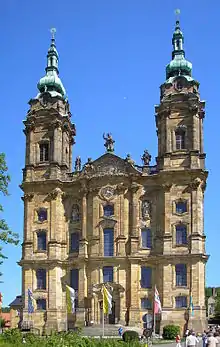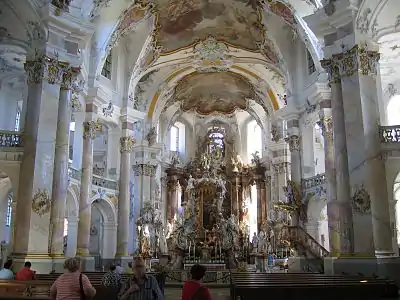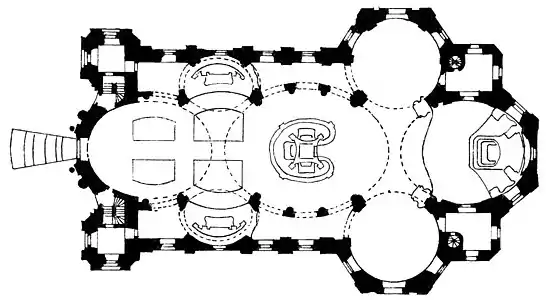Basilica of the Fourteen Holy Helpers
The Basilica of the Fourteen Holy Helpers (German: Basilika Vierzehnheiligen) is a church located near the town of Bad Staffelstein near Bamberg, in Bavaria, southern Germany. The late Baroque-Rococo basilica, designed by Balthasar Neumann, was constructed between 1743 and 1772. It is dedicated to the Fourteen Holy Helpers, a group of saints venerated together in the Catholic Church, especially in Germany at the time of the Black Death.
| Basilica of the Fourteen Saints | |
|---|---|
Basilika Vierzehnheiligen | |
 The Basilica of the Fourteen Saints | |
 Basilica of the Fourteen Saints | |
| Location | Bad Staffelstein |
| Country | Germany |
| Denomination | Roman Catholic |
| Architecture | |
| Architect(s) | Balthasar Neumann |
| Style | late Baroque-Rococo |
| Years built | 1743-72 |
Location

The Basilica overlooks the river Main in Franconia. It sits on a hillside, and on the hillside opposite is Schloss Banz, a former Baroque abbey. Together they are known as the Goldene Pforte or golden portal, an entryway to the historic Franconian towns of Coburg, Kronach, Kulmbach and Bayreuth.
Legend
In the fall of 1445, young shepherd Hermann Leicht saw a crying child in a field near a Cistercian monastery in Langheim. As he bent down to pick up the child, it abruptly disappeared. A short time later, the child reappeared in the same spot along with two floating lights and Hermann reported it to the Cisterians. The next summer, he saw the child a third time. This time, the child bore a red cross on its chest and was accompanied by other figures. The child said they were the fourteen helpers and would help others if a chapel was erected for them. The two lights descended and the vision disappeared, after which the healing miracles began.[1][2]


The Cistercian brothers to whom the land belonged erected a chapel, which immediately attracted pilgrims. An altar was consecrated as early as 1448. Pilgrimages to the Vierzehnheiligen continue to the present day between May and October.
The mercy altar of the Vierzehnheiligen
The fourteen saints represented in the altar are:
- On the balustrade:
- Blaise (also Blase and Blasius) (February 3), bishop and martyr, invoked against illness of the throat
- Cyriacus (Cyriac) (August 8), deacon and martyr, invoked against temptation on the death-bed
- Denis (Dionysius) (October 9), bishop and martyr, invoked against headache
- Erasmus (Elmo) (June 2), bishop and martyr, invoked against intestinal ailments[3]
- In the altar niches:
- Barbara (December 4), virgin and martyr, invoked against fever and sudden death
- Catherine of Alexandria (November 25), virgin and martyr, invoked against sudden death[3]
- On the buttresses:
- Agathius (or Acacius) (May 8), martyr, invoked against headache
- Christopher (Christophorus) (July 25), martyr, invoked against bubonic plague
- Eustachius (Eustace, Eustathius) (September 20), martyr, invoked against family discord
- Giles (Aegidius) (September 1), hermit and abbot, invoked against plague, for a good confession[3]
- On top of the baldachin:
- George (April 23), soldier-martyr, for the health of domestic animals
- Margaret of Antioch (July 20), virgin and martyr, invoked in childbirth
- Pantaleon (July 27), bishop and martyr, for physicians
- Vitus (June 15), martyr, invoked against epilepsy[3]
The high altar of Vierzehnheiligen

The central scene of the unobstructed and towering high altar is a larger-than-life painting showing the Assumption of the Blessed Virgin Mary. The statues depict her spouse Joseph, her father Joachim, and David and Zachariah.
Pulpit
Free floating white putti bear the pulpit ornamented with the golden reliefs of the Evangelists surrounded by shellwork. The pulpit tester (sound board) is made of rays in a spherical shape.
See also
References
Citations
- Wilson 2016.
- Hlaváček 2015, p. 90.
- Michelin 1967.
Sources
- Hlaváček, Petr (2015). Translated by Zdeněk, V. David. "Konrad Konhofer († 1452) as an Opponent of Jan Hus and the Bohemian Reformation" (PDF). The Bohemian Reformation and Religious Practice. Prague: Academy of Sciences of the Czech Republic. 10 (2): 60–105. ISBN 978-80-7007-446-6.
- Wilson, Andrew L. (2016). Here I Walk: A Thousand Miles on Foot to Rome with Martin Luther. Grand Rapids, MI: Brazos Press. p. 240. ISBN 978-1-493-40576-3.
- Michelin Green Guide to Germany (reprint ed.). The Dickens Press. 1967. p. 264.
External links
| Wikimedia Commons has media related to Basilika Vierzehnheiligen. |